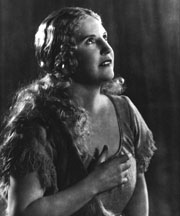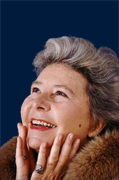 Kirsten
Flagstad was a singer who has often discussed as having a ‘haunting
color’ to her voice; a special timbre that invites an emotional
response from the listener. Notice that her tonal quality is immediately
identifiable, a result of correct training. But there are other factors
beyond the pure voice that can create a special performance. Some singers
may not have a specific vocal sound like Flagstad, yet the voice may
inspire an emotional response from the listener. One characteristic in
a performance that touches an audience most is that of communicating
feeling or emotion, offering the listener an experience with which he/she
can identify personally. Kirsten
Flagstad was a singer who has often discussed as having a ‘haunting
color’ to her voice; a special timbre that invites an emotional
response from the listener. Notice that her tonal quality is immediately
identifiable, a result of correct training. But there are other factors
beyond the pure voice that can create a special performance. Some singers
may not have a specific vocal sound like Flagstad, yet the voice may
inspire an emotional response from the listener. One characteristic in
a performance that touches an audience most is that of communicating
feeling or emotion, offering the listener an experience with which he/she
can identify personally.
For the younger singer/student, it is important to study a performer’s ‘intention’ to
communicate, an aspect of singing that is often present in internationally
famous singers. Learning the skills that can move a performance to a
deeper level is very important for any singer who wants to accomplish
a high level of career performing. In a world where electronic stimulation
is wide spread through digital video and audio formats, some have not
had the special experience of attending an exceptional live performance.
Those of us who have had such opportunities know that a good live performance
is extremely different from digitally produced video or audio recordings.
First of all, live performance offers a three-dimensional form of human
expression, one that cannot be replicated in the same exact form. Many
of us realize that there will never be any two live performances that
are exactly the same, even if the performer is consistent in his/her
presentation. Since performance energy varies from day to day, It is
extremely important that young professional singers become comfortable
with these slight variations in their level of performance, while still
working toward consistency. None of us wants one great performance followed
by one that feels unsuccessful. Consistency in preparation, which involves
the discipline of daily practice, can result in consistency in the performance
arena. Balance in vocal technique is a positive factor in achieving performance
consistency, but remember that performing involves more than just a special
or beautiful voice. A special performance involves a combination of voice,
body usage, and emotional expression, which is also connected with musicianship.
How we express ourselves is a direct outgrowth of intention.
What do you intend to communicate? What feeling do you intend to convey
to the listener? A professional international singing artist develops
performance and stage skills in addition to vocal development. Efficient
performing is an outgrowth of both preparation (experimentation) and
experience (performing repeatedly). For both audition and performance
preparation, I recommend Janet Williams’ book, “Nail Your
Next Audition” (www.nailyournextaudition.com),
a fine and rare example of learning preparatory skills for the singing
artist. This book is literally full of ideas on communication skills
and how to develop the self-confidence that allows a singer to compete
in the professional arena.
 Preparatory Skills: As human beings, we feel differently
every day, adjusting to slight changes in the sensations of the voice,
body energy, and emotions. As a vocal preparatory skill, Kirsten Flagstad
used to study the hall and embrace it as a resonator for her voice, never
considering it a space to fill with sound. This was a type of self-study,
which released what could have developed into a negative emotional response
to a large hall. Birgit Nilsson once said at a master class, “During
my career, I had about 50 days when my voice and psyche felt nearly perfect
and I only had 2 performances on any of those 50 days!” She was
emphasizing the fact that the vocal and mental discipline in performance
preparation challenges even the strongest performer, demanding specific
emotional and vocal preparatory skills. During my study with Alan Lindquest,
he once said, “When I sang on tour across the United States, I
often had 10 performances per week, 7 days per week. Sometimes I was
not feeling very well, or I was tired. BUT when I came out on stage and
saw the glowing faces of the people in the audience, something else took
over, a performance energy that was inspired by a desire to communicate
to the audience!” Lindquest’s account is one that is shared
by many professional singers, and it exemplifies why singers are true
athletes, making self-care (physical and mental preparation) a critical
factor toward a balanced performance. Preparatory Skills: As human beings, we feel differently
every day, adjusting to slight changes in the sensations of the voice,
body energy, and emotions. As a vocal preparatory skill, Kirsten Flagstad
used to study the hall and embrace it as a resonator for her voice, never
considering it a space to fill with sound. This was a type of self-study,
which released what could have developed into a negative emotional response
to a large hall. Birgit Nilsson once said at a master class, “During
my career, I had about 50 days when my voice and psyche felt nearly perfect
and I only had 2 performances on any of those 50 days!” She was
emphasizing the fact that the vocal and mental discipline in performance
preparation challenges even the strongest performer, demanding specific
emotional and vocal preparatory skills. During my study with Alan Lindquest,
he once said, “When I sang on tour across the United States, I
often had 10 performances per week, 7 days per week. Sometimes I was
not feeling very well, or I was tired. BUT when I came out on stage and
saw the glowing faces of the people in the audience, something else took
over, a performance energy that was inspired by a desire to communicate
to the audience!” Lindquest’s account is one that is shared
by many professional singers, and it exemplifies why singers are true
athletes, making self-care (physical and mental preparation) a critical
factor toward a balanced performance.
Intention is the triggering factor that creates motion. The basis of
artistic expression is motion, whether it is in the area of instrumental
music, dance, singing, painting, theater or any art form. Motion is what
keeps an audience interested, striking interest through intention. Creativity
travels through a performer’s intention, which stems from specific
concentration. If intention is NOT a part of a singer’s discipline,
then the result can be a studied sound, which can be boring to the audience.
If a singer is to compete in the professional arena, it is critical that
he/she learn the power of expression and what fuels it.
It is a well known fact that some performers are shy, but when they
get on stage, they feel a freedom to express beyond their shyness. This
energy that takes over in such a setting is fueled by intention.
Mental Discipline and Knowing the Inner Self: A solid
basis for any individual is that of emotional balance, which allows the
singer to be comfortable with self-study. One powerful tool for self-study
is that of the video camera, which allows us to experience our personalities
from a different point of view. Knowing how we come across on film is
a powerful tool toward measuring one’s balance in communication,
and it is a critically powerful basis for achieving balance in performance.
Many singers develop and require different preparation tools and the
video camera can expose the missing pieces in a singer’s communication
skills.
 Another tool that is important to every performer is to learn through
self-study exactly what emotional and technical tools fully prepare them
for a performance. Many say that they need alone time, without a lot
of conservation. Knowing the inner emotions allows an individual performer
to learn emotional preparatory skills, skills specific to his/her needs.
Whether it is alone time, meditation, or reading an inspirational passage
from a book, these skills are necessary to establish personal comfort
before going out on stage. Every singer is different in these needs and
knowing the inner self will prepare any individual in developing appropriate
mental preparation for their specific needs. I recently warmed up a singer
for a performance with the Cleveland Symphony. My way of approaching
this kind of warm up situation is that I tell the singer, “Let
me know when you have reached the point of warming the voice that is
perfect for your vocal needs today. It is your time!” Every singer
knows his or her voice more than anyone else, and allowing the singer
the freedom to make this decision is extremely important in a warm up
that is part of performance preparation. Another tool that is important to every performer is to learn through
self-study exactly what emotional and technical tools fully prepare them
for a performance. Many say that they need alone time, without a lot
of conservation. Knowing the inner emotions allows an individual performer
to learn emotional preparatory skills, skills specific to his/her needs.
Whether it is alone time, meditation, or reading an inspirational passage
from a book, these skills are necessary to establish personal comfort
before going out on stage. Every singer is different in these needs and
knowing the inner self will prepare any individual in developing appropriate
mental preparation for their specific needs. I recently warmed up a singer
for a performance with the Cleveland Symphony. My way of approaching
this kind of warm up situation is that I tell the singer, “Let
me know when you have reached the point of warming the voice that is
perfect for your vocal needs today. It is your time!” Every singer
knows his or her voice more than anyone else, and allowing the singer
the freedom to make this decision is extremely important in a warm up
that is part of performance preparation.
So knowing the inner self is a foundation for preparing psychologically
for a stage performance. Awareness and knowledge of self are powerful
tools that make this kind of preparation possible.
Mental preparation is certainly an aspect of performing that is beyond
a beautiful vocal sound. When a professional singing artist moves onto
the stage, he/she must include musical skills, interpretive skills and
concentration (emotional) skills into the venue. An excellent performance
requires knowing the inner self, and use of psychological tools to create
a more balanced performance is a gift for every singer.
 Getting Out of Your Way: We all have experienced
fear as an emotional part of performing. Often stemming from attempting
to please parents or peers, this fear is most easily dealt with using
emotional tools, or even acting tools. I remember a couple of years ago,
I decided to sing on a master class after I had taught for several hours.
Due to my history of having difficult performances as a tenor, I still
have a nervous response. But I dealt with it through an acting took.
I suddenly became an internationally famous singer in a concert hall,
and this psychological tool took away the nerves. You will find more
tools in Janet Williams’ book, “Nail Your Next Audition”. Getting Out of Your Way: We all have experienced
fear as an emotional part of performing. Often stemming from attempting
to please parents or peers, this fear is most easily dealt with using
emotional tools, or even acting tools. I remember a couple of years ago,
I decided to sing on a master class after I had taught for several hours.
Due to my history of having difficult performances as a tenor, I still
have a nervous response. But I dealt with it through an acting took.
I suddenly became an internationally famous singer in a concert hall,
and this psychological tool took away the nerves. You will find more
tools in Janet Williams’ book, “Nail Your Next Audition”.
 Power IS Intention: Many singers who are on the path
of an international career realize that the word ‘intention’ holds
great weight, both in the expression of the music, and in the level of
energy required to perform. Mental preparation is part of a performer’s
list of skills in order to achieve what many call stage presence.
Since emotions inspire a response, we can use word thoughts that trigger
colors in the voice. Joseph Hislop used the three contrasting emotions
of joy, sadness, and anger, having the singer use these emotions in the
say key and in the same vocal exercise. The resulting changes in vocal
timbre are simply a response to the different emotions. Yet because they
are preformed in the same key with a familiar exercise, the singer develops
vocal consistency within emotional diversity. Alan Lindquest often used
the word ‘intention’ in order to fuel a singer’s energy. “Take
the breath as though you have something to say!” It is critical
for each singer to ask, “What is my language, musical, or dramatic
intention in this phrase?” While vocal technique is critically
important in establishing a solid vessel of expression, connecting all
aspects of intention moves the singer toward accomplishing a successful
performance. Power IS Intention: Many singers who are on the path
of an international career realize that the word ‘intention’ holds
great weight, both in the expression of the music, and in the level of
energy required to perform. Mental preparation is part of a performer’s
list of skills in order to achieve what many call stage presence.
Since emotions inspire a response, we can use word thoughts that trigger
colors in the voice. Joseph Hislop used the three contrasting emotions
of joy, sadness, and anger, having the singer use these emotions in the
say key and in the same vocal exercise. The resulting changes in vocal
timbre are simply a response to the different emotions. Yet because they
are preformed in the same key with a familiar exercise, the singer develops
vocal consistency within emotional diversity. Alan Lindquest often used
the word ‘intention’ in order to fuel a singer’s energy. “Take
the breath as though you have something to say!” It is critical
for each singer to ask, “What is my language, musical, or dramatic
intention in this phrase?” While vocal technique is critically
important in establishing a solid vessel of expression, connecting all
aspects of intention moves the singer toward accomplishing a successful
performance.
 THE primary motivator that directly influences vocal color is that of
intention in singing. Many years ago, I heard a recital by the great
Christa Ludwig. Every word of every song involved intention to communicate.
A seasoned artist by that time, there was no question what was intended
in each musical phrase. Every word led (in crescendo or decrescendo)
toward a higher or lower point in the musical phrase, offering excitement
even in the slowest of tempi. I had a similar experience with Jose Van
Dam in a recital at Lincoln Center in New York. Both of these artists
are exactly that, artists. Inspired sound is feeling in motion, and each
of these singers moved within each word as though it was the upward or
downward stroke of a great painter’s brush. THE primary motivator that directly influences vocal color is that of
intention in singing. Many years ago, I heard a recital by the great
Christa Ludwig. Every word of every song involved intention to communicate.
A seasoned artist by that time, there was no question what was intended
in each musical phrase. Every word led (in crescendo or decrescendo)
toward a higher or lower point in the musical phrase, offering excitement
even in the slowest of tempi. I had a similar experience with Jose Van
Dam in a recital at Lincoln Center in New York. Both of these artists
are exactly that, artists. Inspired sound is feeling in motion, and each
of these singers moved within each word as though it was the upward or
downward stroke of a great painter’s brush.
Exercises:
- Stand in front of a mirror and work on three contrasting emotions.
Look at your facial expression and learn how it affects your facial
posture for singing. Try to interpret these emotions without distorting
a healthy facial posture.
- Study your face with no expression. Think of it as a blank canvas.
Then go into an expression of sadness, anger, or joy. Study what your
facial muscles are doing and be careful not to pull down the soft palate,
or thrust the jaw forward, or thrust the head forward. Learn expression
with healthy posture.
- Sing a musical phrase on any vowel, BUT keep in mind the meaning
of every word. Paint the vocal color that you want to express. Make
the vocal color match the emotion. ALSO, make sure that every note
is moving up or down in volume, in order to develop consistent intention
of motion.
Additional vocal information can be found at David Jones’ web
site, www.voiceteacher.com.
His instructional CD is available at www.cdbaby.com.
Janet Williams’ book, “Nail Your Next Audition” is
available at www.nailyournextaudition.com
Please address any questions to info@voiceteacher.com
© 2008 by David L. Jones

  
|

